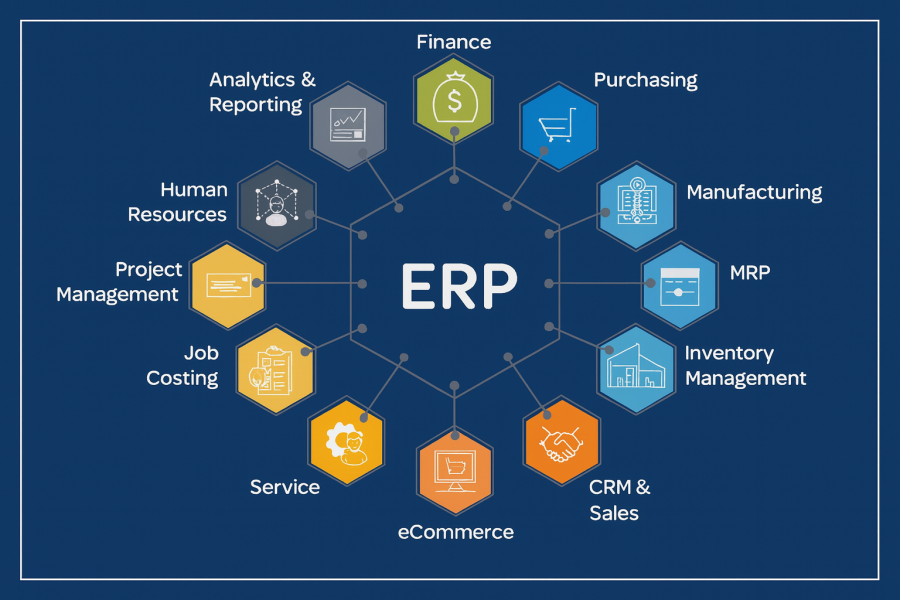- inquiry@v10x.com
- DSK Rohit, office No-13, 3rd Floor, 1264/2 Apte Road, Deccan Gymkhana, Shivajinagar, Pune - 411 004. Maharashtra, INDIA
How ERP Centralizes Business Operations
- Home
- Blog Details
How ERP Centralizes Business Operations
Managing a business today means dealing with a complex web of processes — from sales and finance to HR, supply chain, and customer service. When these functions are managed in silos using different tools and spreadsheets, inefficiencies creep in. Miscommunication, duplicate data, and delays often slow down growth.
This is where ERP (Enterprise Resource Planning) makes a difference. ERP software is designed to centralize operations by bringing all business processes onto one unified platform. Instead of every department working in isolation, ERP connects them, creating a single source of truth that improves efficiency, accuracy, and collaboration.
What is Centralization?
In simple terms, centralization means having one system where everything connects. Imagine your sales team, finance team, HR, and warehouse staff all working with the same set of data in real time. There’s no need to reconcile multiple spreadsheets or send endless emails — everyone has access to the same accurate information.
Centralization doesn’t just save time; it changes how a business operates. It ensures consistency, improves communication, and creates transparency across the organization.
How ERP Centralizes Operations
Here are the key ways ERP brings everything together under one roof:
1. A Unified Database
At the heart of ERP lies a centralized database. Whether it’s customer details, financial transactions, or stock levels, everything is stored and updated in one place. For example:
i.When sales enters a new order, inventory levels update instantly.
ii.Finance can generate an invoice without asking sales for details.
iii.Management can view accurate dashboards at any moment.
This removes the risk of duplicate or outdated data, ensuring everyone works with the same version of truth.
2. Integrated Modules for Every Function
ERP systems come with interconnected modules covering different departments:
i.Finance – Automates accounting, billing, and expense tracking.
ii.Sales & CRM – Tracks customer interactions, leads, and orders.
iii.Inventory & Supply Chain – Monitors stock, warehouses, and procurement.
iv.HR & Payroll – Manages employees, attendance, and salaries.
v.Manufacturing & Projects – Plans production schedules and project timelines.
Since these modules are linked, one action in a department triggers updates everywhere else. For example, a purchase order in procurement updates accounts payable in finance and stock in inventory.
3. Streamlined Workflows
Without ERP, approvals and processes often get stuck in endless email chains. ERP automates and simplifies workflows:
i.A leave request moves from employee → manager → HR → payroll, all inside the system.
ii.A purchase order goes from requisition → approval → vendor → inventory without manual intervention.
This speeds up operations, reduces delays, and ensures accountability at every step.
4. Real-Time Collaboration Across Departments
Centralization encourages collaboration. Sales can instantly check if an item is in stock before making a commitment to a customer. HR can coordinate with finance for payroll adjustments without chasing data. Management can view cross-departmental reports without waiting for manual updates.This connectedness improves communication and keeps all teams aligned.
5. Data-Driven Decision-Making
In the absence of ERP, leaders often rely on reports that are outdated by the time they’re compiled. ERP changes this by providing real-time insights and analytics. For example:
i.A retail business can see which products are selling fastest and adjust inventory instantly.
ii.A manufacturing unit can track machine downtime and plan maintenance proactively.
iii.Data centralization gives leaders confidence to make faster, more informed decisions.
Why Centralization Matters for Businesses
When operations aren’t centralized, businesses often face:
1.Duplicate records and manual errors.
2.Time wasted in reconciling data from multiple tools.
3.Poor customer service due to miscommunication.
4.Higher costs from inefficiency and delays.
By centralizing operations, ERP ensures that the business runs like a well-oiled machine. Every department is connected, processes are smoother, and leaders can focus on growth instead of firefighting.
Real-Life Example of ERP Centralization
Let’s consider an e-commerce company without ERP:
1.Sales receives an order but doesn’t know inventory is low.
2.Warehouse discovers the shortage late, delaying shipment.
3.Finance prepares an invoice manually, leading to errors.
4.Customer service deals with complaints about delays.
Now with ERP:
1.The moment sales creates an order, inventory updates automatically.
2.The warehouse gets notified in real time.
3.Finance generates the invoice instantly.
4.Customer service has complete visibility into the order status.
The difference is clear: fewer errors, faster processes, and happier customers.
The Bigger Picture
Centralization is no longer a luxury — it’s a necessity for businesses that want to stay competitive. ERP systems bring departments, data, and processes together into one powerful platform. By doing so, they help businesses eliminate inefficiencies, make smarter decisions, and scale with confidence.



Write A Comment